This is another speciality produced by the Company and is included because of the pure numbers indicated by this advertisement. Fortunately, there are also collectors who have provided photographs to prove the existence of a non gas item, doubtless produced for the railway companies who were extremely good customers for their gas fixtures.
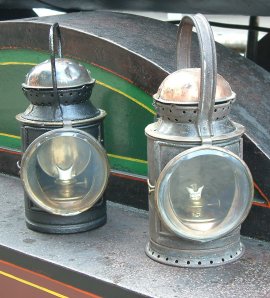
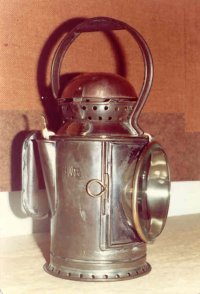
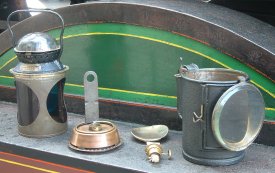
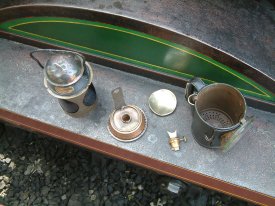
Lamp in stripped state showing the rotatable inner with coloured glass, the oil container, wick holder with porcelain nozzle and removable reflector. The front lens hinges open to allow for lighting. The pierced inner base can be seen providing a protected route for the air for combustion from a ring of holes around the base which are more obvious on the other model.
Petroleum (Oil) Hand Lamps.
The patents refer to the way in which the glass is fitted to allow for replacement without tools and to a breather arrangement which prevents oil spillage should the lamp be knocked over.
The pair of hand lamps shown together belong to the collection of Kevin George and are photographed on a suitably dated steam engine in the Sheffield Park station of the Bluebell Railway in Sussex. The other GWR lamp was photographed in the Sugg Lighting factory many years ago when it was brought in by its owner whose name has unfortunately escaped!
Kevin George writes:
“These lamps are believed to be the forerunner of what became the GWR ‘Paddington’ lamp. Prior to 1923 there were a few railway companies that bought these examples, those being the GWR, Rhymney Railway Co (RRCo), Brecon & Merthyr Railway (B&MR), and also the Liskeard & Looe Railway (L&LR). There may well be others but I am unaware of them at this time. After 1923 the GWR took over most of the Welsh companies and the pattern of these lamps went on, albeit they were manufactured by other companies by this time. The pattern and style even went into the BR days after the 1948 nationalization.”
“The fact that they were classed as ‘Petroleum’ lamps caused some confusion among a lot of railway workers, bearing in mind that when the majority of hand lamps across the board went over to paraffin the lamps were plated ‘Petroleum’ to distinguish between paraffin from colza, or rape oil as it is better known. A Dr James Young obtained the patents for extracting Petroleum oil, or paraffin as it is better known from bituminous coal in the early 1800s, therefore petroleum was plated on most lamps. After several railway employees mistook it for petroleum spirit it was decided to change the plates to Kerosene.”
“The operation of the lamp was done by turning the top which rotated an inner drum with coloured glass, to bring the required colour aspect in line with the front lens. This construction can be seen in the picture of the lamp in a stripped state.”
This one section should perhaps be included within ‘Collectors’ but, although a genuine Sugg product, it is not a gas product so has been given its own section. I am convinced that William Sugg was approached by GWR, with whom he had worked for many years with gas lamps, complaining about the shortcomings of their then hand lamps. His knowledge of ventilation and air movements within gas lamps was soon applied to the oil lamp resulting in a lamp which became the ‘standard’. GWR doubtless retained the design rights – so had presumably paid William Sugg for the development – and in due course the lamp was manufactured by many others. As you can see from the advert at the top GWR alone took 15,000 lamps.
In 2011 I had the opportunity of seeing the amazing collection of hand lamps amassed by Kevin George. This one picture will give you some idea of what the title ‘Collector’ really means!
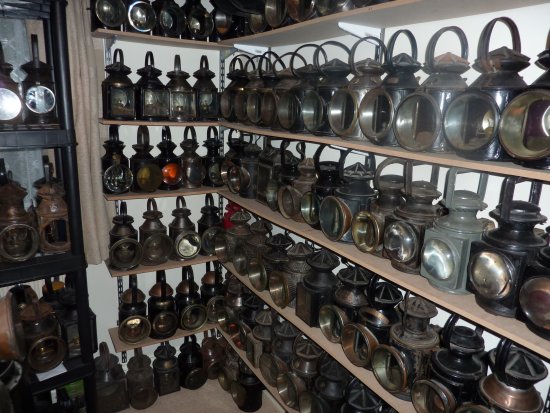
If you wish to contact Kevin George to discuss oil hand lamps his email address is ke*************@*****ok.com
—————————–
This Article from Railway Engineer of August 1906 explains the advantages of the Wright’s Patent lamp and we learn the reason behind the change to ‘Petroleum Oil’ against the earlier colza or rape oil. Clearly this is before the problems associated with the misuse of ‘Petroleum Spirit’.

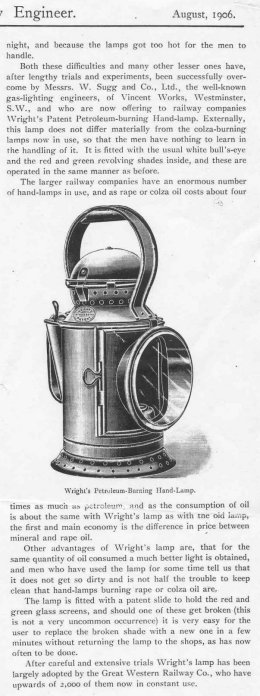
Export
Since publishing this website there have been many contacts from enthusiasts and collectors of various Sugg related products. ‘Hand lamps’ is one of these categories, doubtless because of the huge interest in all things related to the railways. This picture and others were sent to me from New Zealand by a collector who was showing at a local Antique and Bottle Show in October 2006 and he got a first equal for his hand lamp display! I have an email address if anyone wishes to contact him.
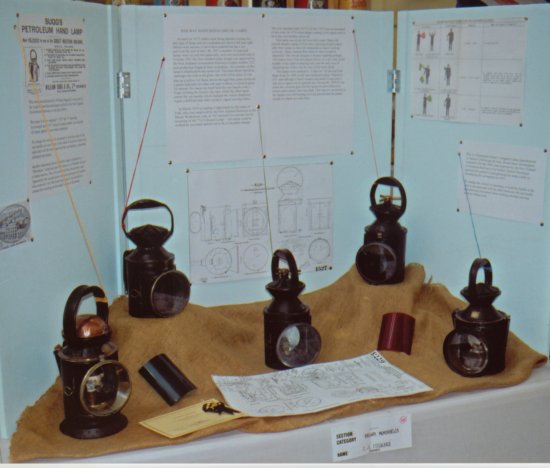
Antique & Bottle Show October 2006. Sugg hand lamp on the left
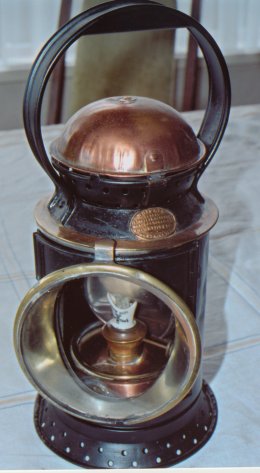
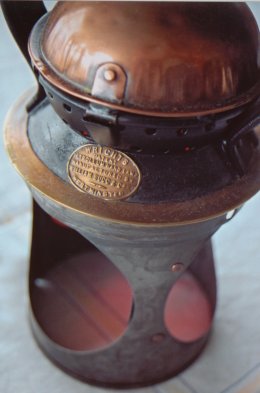
My correspondent said: “I am a railway collector and historian in New Zealand, and have in my possession one of the patent lamps, which is in excellent order and complete. It would appear from my research that it was brought by New Zealand Railways, probably in the early 1900’s as they trialled a number of lamps including the Corrugated iron lamp which I also have one of. Getting back to the Wrights Patent one, it is stamped and has a number as being used at Invercargill South Island New Zealand.” “The other Wrights Lamp is at the Ferrymeade Museum at Christchurch ready to go on display when they get their National Rail Museum set up. As far as I know there are only two Wrights patent lamps known to be in NZ.”
Does anyone else know better?!
Copyright © Chris Sugg 2006-13
Back to ‘Lighting‘

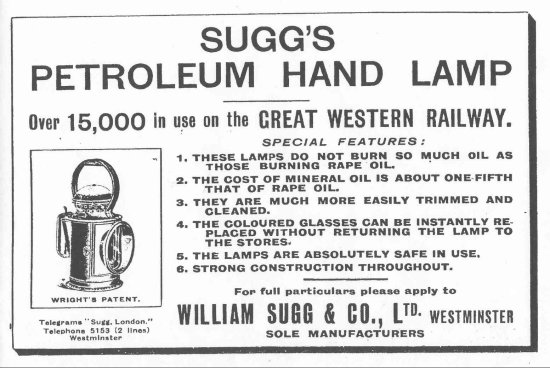
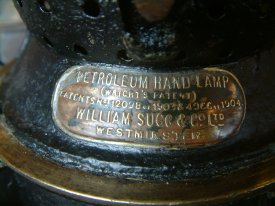
21 responses
Hi , just become a owner off two lamps , got them at a farm sale on Dorset . Thank you .
Hope the information you can find on this site proves helpful with your new lamps.Chris
Where can I get some of the coloured glass, As the lamp I’ve got has a damage blue piece and two bits missing ???
Stephen, As you will have seen in the hand lamp details this speciality really belongs to Kevin George who lives in Crowborough. I will forward your enquiry to him and, doubtless he will have something to say. Regards, Chris
Stephen, I have forwarded your enquiry to Kevin George who knows more about oild hand lamps than anyone else I know. Chris
Hi I have a lamp with no identifying marks or coloured glass. I wondered if you could forward on my details to Kevin so I can send him some photo’s
Regards
Brett
I have forwarded your enquiry to Kevin. Chris
I was wondering if you knew anything about 19th century hand lanterns that were used on British sea going vessels. Also, I read that the word “bowat” was a Scottish word for a small hand lamp. Are you familiar with the use of that word associated with the lamps you have dealt with?
David, I am afraid this is not an area or a word that I have come across. The only hand lanterns made by Sugg were for the railways and were obviously fuelled by oil, which apart from occasional electric fixtures is the only time they did not use gas! Sorry, Chris
Hi I have an old railway Adlake 55/2 signal lamp but it needs a wick holder with a long handle to turn outside when closed and a brass screw stopper at the moment it’s got a cork in it and noticed it had a screw thread so I just wondered if you had one or knew anybody that has one or both for sale thanks
Ian, I am no expert on oil lamps but you will have seen that there is one super specialist collector. I will forward your enquiry to him.
Can you be more specific? Which section and if possible the pictures – or some – that are causing a problem? Thank you.
I am looking for a Locomotive paraphin Head lamp . The little white ones you see on heritage railroads. I’m looking for a WW2 Era piece. I live in the San Francisco area of California so I can’t go Antiqing in the UK easily. This is a new interest for me and associated with my model Railroad. I have included several OO scale Locomotives along with my HO layout based on the Ports of Oakland and Richmond California during 1942 43. If you can help this old injured warrior fulfill a dream I’d appreciate it so much.
Thank you
Michael_h_mcmillen @ Yahoo.com
Michael, do you mean hand lamp? The expert on railway hand lamps is mentioned on that section so I have just copied your enquiry directly to him. I hope he can help you. My connection with oil hand lamps is simply because William Sugg was asked to improve the design and came up with what became the standard and was manufactured by several companies as well as by WS & Co.
Hi, iam looking some help with an old railway lamp it’s a 55/4 Planlite iam looking for information on how to change the wick it looks as if it has got two
Regards Stephen
Hi Stephen, You need to contact the expert on oil lamps who is mentioned in that section. Although William Sugg designed and made that particular hand lamp it is not an area that I know about. The man you want is Kevin George and his email address is under the picture of (part) of his collection! ke***********@********co.uk Just mention you got his email address from the William Sugg History site.
Sorry, you will just have to call back. I know that is not efficient but that’s where we re at the moment!
Hi, I have my Granddads lamp , it has L&SWR on it, so dates before 1922. I would like to know everything about it! I can not find who manufactured these lamps for L&SWR, or what the materials are. Any information will be appreciated, thanks
Paula, I have replied by email after your enquiry was passed to me from the new William Sugg manufacturing company. Still trying to find Kevin George!
I picked up an old lamp that I assume is a railway lamp although I may be wrong, it has, as one might expect an oil bath but in one of the corners there is a pretty prominent hole, it looks to be intentionally placed there although as you would expect if you try to fill it up it leaks immediately, how should go about fixing this?
Hi Sam, the expert on oil hand lamps is mentioned on the page you viewed with that name. He has a new email which he has said I could pass on but I will send it as an email copied to you both and I suggest you send a photo or two
Chris